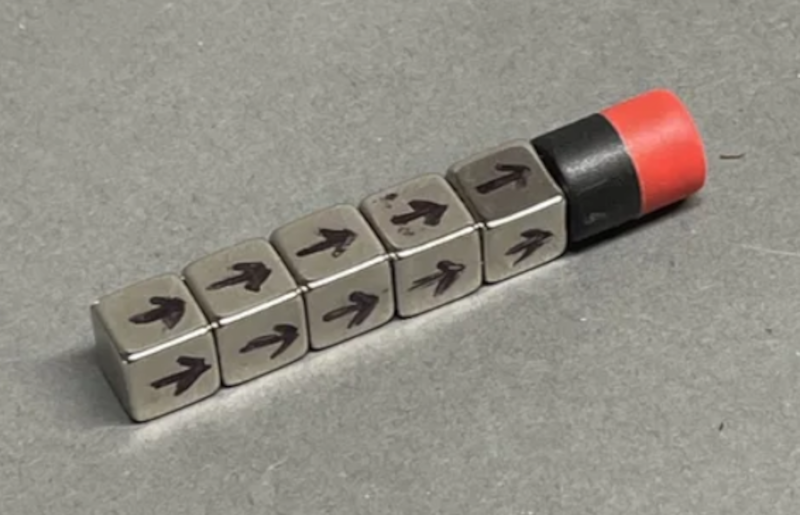If you want a strong magnet, the obvious answer is to buy one. However, for a variety of reasons, you might want to combine several smaller magnets. There are a few ways to do this, but the Halbach array, as [wannabemadsci] explains, allows you to make an array of magnets where one side is very strong, and the other side is very weak.
The example uses a 3D-printed housing and five cube magnets. To form a Halbach array, the poles of the magnets are in a specific orientation that effectively rotates ninety degrees for each — in this case — cube.
The fields add and cancel each other so that you get the most magnetic lines of force on one side and very few on the other side. This might seem like a curiosity, but there are a range of practical applications. Maglev trains are one example. Brushless motors and free electron lasers can take advantage of the effect, too.
You can also have a halbach cylinder with all the magnetic flux inside the ring and practically none outside. You can read more about the math and applications on Wikipedia. If you think cylinders sound familiar, maybe you are thinking about core memory. Don’t understand magnets? We aren’t sure anyone understands them completely, but we try.

















>Magents ? Typo???
Argh
The “magent” in the email subject worked like a click bait because I got curious if it was something related to color changing according to magnetic field :D
No mention of cyants, blackts, or yellowts either!
B^)
You… really had to ask???? Even with a picture????
…and refidgeratir seals!
Hmmm the picture is not of a halbach array; the point of a halbach array is the the poles are *not* aligned.
It takes a structure to force them into a halbach array, you can’t just stick them together like the pic shows.
+1
And if they’re decent magnets it takes a fair bit of force to jam them into the halbach array. They really don’t like it. What I’ve found works is putting alternate ones in place, gluing them in, and then forcing in the remaining ones as they’re so tight they can’t easily twist while you’re placing them. But I too mark each one with arrows so I’m sure it went in right and didn’t twist while I wasn’t paying quite enough attention.
I first learned about Halbach arrays back in middle school when I came across the research of Richard Post. He was working on a really clever levitating train system that didn’t require superconductors or any active power for levitation aside from some sort of forward push which induced an opposing magnetic field in the track made of dense closed coils. Despite getting on in age, he was one of the first “real scientists” that answered an emails from a random kid. Pretty rare for the early days of the internet!
The Inductrack system is pretty dang clever but despite positive results during full-scale testing at Lawrence Livermore National Laboratory followed by and three design iterations, it just never seemed to catch on.
Post passed away in 2015, just 2 years after the last patent was issued for Inductrack III, which was designed for hauling large loads. The last time I’ve seen the tech mentioned was back in 2016 with one Hyperloop-inspired company, hyperlooptt, using it in tandem with the hyperloop low-pressure monorail design. It also seems they own the trademark on Inductrack and proudly state their usage of a Halbach array configuration in their technology page.
The hyperlooptt project seems to be active, so maybe Post’s work wont die with him. It’s such a neat idea, I hope it does live on.
A Halbach array is not the minimum energy state for the permanent magnets- it’s more like a wound spring. Will it “relax” over time and re-align the fields to become weaker?
I would think as long as the magnets don’t get heated near their curie point hey should be fine
Does a hallback induce internal heat when the fields interact in opposition?
Yes, depending on its coercivity, but for modern rare earth magnets this is extremely slow, on the order of 0.1%/year. However, that may be higher in a strong magnetic field that opposes the magnet’s own field.
I remember in the past being told that magnets could weaken enough to be useless if kept in opposition for a long time. Much more than when in isolation.